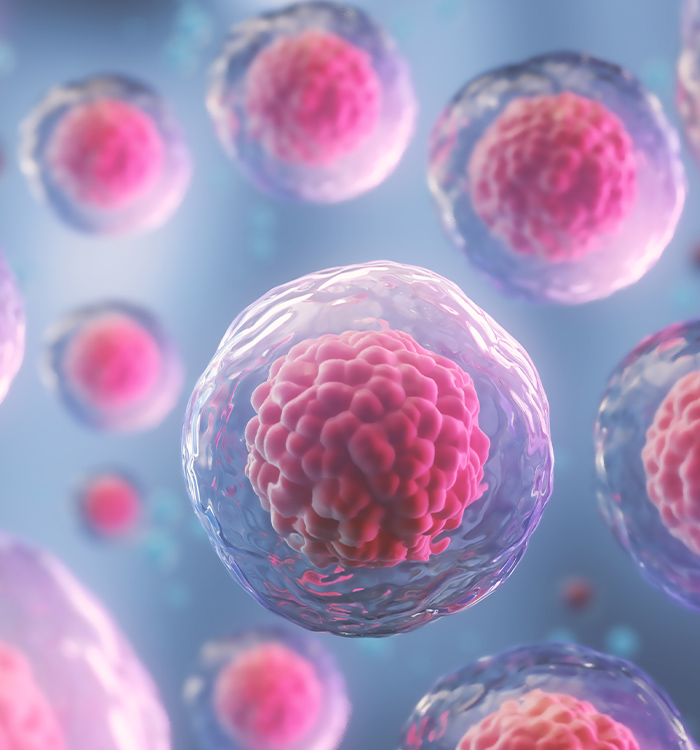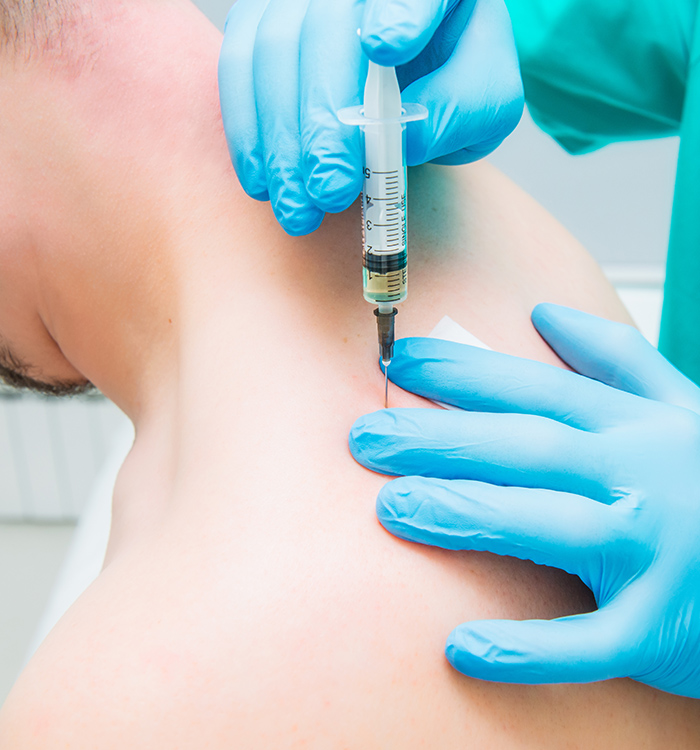
Regenerative Medicine – Asheville, NC
Get Active and
Free From Pain
Regenerative medicine refers to the use of the body’s own innate healing mechanisms to help a patient recover from injury and pain. It’s designed to boost someone’s own natural healing response and direct it to a specific area of the body. This can be accomplished using a few different techniques for regenerative medicine in our Asheville, NC office, all of which can be completed right here in an hour or two. Dr. Pinkston can help determine which approach is best for you based on your situation.
Why Choose Asheville Non-Surgical Orthopedics for Regenerative Medicine?
-
Non-Invasive Solutions to
Chronic Pain -
Treatment Plans Customized
for Each Patient -
Specialist in Neuromusculoskeletal
Treatments & Anatomy
Shockwave Therapy

Ongoing pain from a muscle, tendon, or ligament injury can put a damper on your quality of life and limit your ability to carry out important tasks. Some patients must resort to surgery to find relief, but did you know that for many people, non-invasive options can prevent the need to “go under the knife”? Shockwave therapy is a non-invasive treatment for stubborn injuries that can help Asheville patients to feel better and enjoy life to the fullest.
Learn More About Shockwave Therapy
Biologic Cell Therapy

Mesenchymal stem cell containing tissue can be harvested from various sites of a patient’s own body. Dr. Pinkston obtains these samples from a patient’s own adipose, or fatty, tissue and bone marrow. These biomaterials are then injected under ultrasound guidance into an identified defect. This treatment, known as stem cell therapy or biologic cell therapy, has the potential to speed up your body’s natural healing process and get you closer to a pain-free life.
Learn More About Biologic Cell Therapy®
Platelet Rich Plasma (PRP)

A small sample of your blood is taken and it’s placed in a centrifuge and spun until it separates into distinctive layers. The PRP layer is rich in not only platelets, but other healing proteins and growth factors. Created right in our office, this substance can be injected wherever a patient needs.
Prolotherapy

Dr. Pinkston injects a solution that is a mixture of lidocaine and dextrose—the lidocaine numbs the area, and the dextrose irritates the soft tissues without harming them. This tells the body that something needs to be addressed in the area, which intentionally produces a temporary inflammatory cascade right where the injection is located, with the goal of speeding up the normal recovery processes.
Prolozone®

Prolozone® involves the use of ozone, a gas, in place of or in addition to lidocaine and dextrose. Ozone can also initiate a small, controlled inflammatory process that sends a signal to the body to recruit cells that assist with healing. The ozone (O3) is believed to then dissociate to oxygen (O2) and serve to decrease oxidative stress in the area, which is often a source of pain and may impair the effectiveness of the body’s natural healing response. Prolozone® is used as a standalone treatment or to prepare the cellular environment prior to other regenerative procedures.
Understanding the Cost of Regenerative Medicine

Many patients are excited by the idea of undergoing regenerative medicine therapies, but they hesitate to commit to anything due to concerns about cost. If that is true of you, you can be sure that we understand your feelings! You can count on us to be upfront about your financial obligation so you do not have any unpleasant surprises when the time comes for you to pay. We also have a few provisions in place that might make it easier to afford your care.
What Factors Can Affect the Cost of Regenerative Medicine?

The cost of regenerative medicine may be influenced by a few different factors:
- The specific treatment that you undergo. Stem cell therapy, platelet-rich plasma, prolotherapy, and other regenerative therapies all involve different processes, so they can come at varying price points.
- The extent of your treatment. Some patients notice remarkable results after just one regenerative medicine session. If you have to visit us multiple times to experience improvements, we will bill you accordingly.
- Doctor training and technology. Some physicians are relatively inexperienced with regenerative medicine, so they may charge lower fees. They may also lack the technology to optimize the treatment’s results. In our practice, we combine expertise with state-of-the-art technology to help our patients have the best experience possible.
Does Insurance Cover the Cost of Regenerative Medicine?

Here are a few things to keep in mind about how your insurance may relate to regenerative medicine treatment:
- Most regenerative medicine treatments are not yet widely accepted in conventional medicine circles. Therefore, insurance is not likely to cover them.
- A few regenerative treatments may be covered by insurance. You can communicate with your insurer to find out what they are willing to cover and how much of your treatment’s cost will be your responsibility.
- Our practice does not participate in any insurance plans. However, we are happy to provide documentation that you can submit to your insurance company so they can give you appropriate reimbursement.
How to Make Regenerative Medicine Affordable

If you are concerned about the cost of your care, let us know. We may suggest that you use one of the following to make it easier to fit your treatment into your budget:
- We accept financing through Varidi, a third-party company that offers low-interest and no-interest payment plans for medical services. Our team can walk you through the application process.
- Your HSA or FSA. You may be able to use your healthcare savings account or flexible spending account to help manage the cost of your regenerative treatment.
Would you like to learn more about the cost of regenerative medicine and how you may be able to afford it? Our team is ready to answer your questions! Get in touch with us today.
Regenerative Medicine Frequently Asked Questions

Even though it has been around for decades, regenerative medicine has only recently come into the public consciousness. As such, the average person likely has a lot of questions about it, and Dr. Pinkston and our team are happy to answer them. You’re always invited to give us a call or schedule a consultation to find out more about how these techniques can help you, but first, you can get some basic questions answered by reading our responses below.
Do I need a referral from a doctor to get regenerative medicine?
No, you do not need a referral from your primary care physician in order to get regenerative medicine. Dr. Pinkston is a DO and board-certified in neuromusculoskeletal medicine, so you can just schedule an appointment with him directly. After performing a physical exam and asking about your goals, he can recommend which regenerative method (or methods) might benefit you the most.
How many injections will I need?
This largely depends on how a patient responds to a certain type of injection (be it prolotherapy, PRP, or biologic cells) and the extent of their injury. Some patients respond very well to just one, while others may require multiple injections given weeks or months apart over the course of a year. When you come in for your consultation, Dr. Pinkston will be able to give you a much more detailed estimated timeline of your recovery.
How much does regenerative medicine cost?
The cost of treatment varies from procedure to procedure, and the amount/length of care can be different between patients as well. All cost information will be covered before you receive any care so you know what to expect. It’s important to note that because many parts of regenerative medicine are relatively new, most of our services are not covered by insurance.
What are the risks of regenerative medicine?
The risks of regenerative medicine are relatively limited because in many cases, the therapeutic substance is harvested from the patient’s own body, so there is virtually no chance of complications. It doesn’t have the risk of dependence like pain medication, nor is it invasive like surgery. After an injection, some slight soreness, swelling, and bleeding are common, but these typically stem from the needle itself and go away on their own after a few days (or a week at most).
Do you use fetal, umbilical, or amniotic stem cells?
No. For biologic cell therapy, we harvest mesenchymal stem cell containing tissue from a patient’s body fat or bone marrow. We do not use donated stem cell containing tissue in our practice.